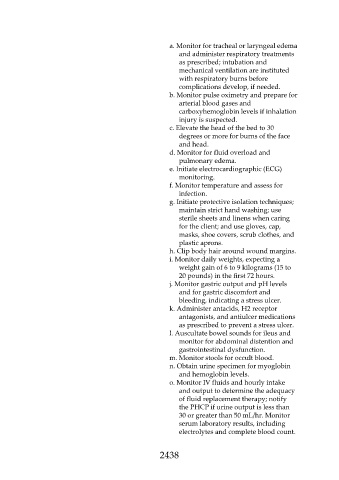Page 2438 - Saunders Comprehensive Review For NCLEX-RN
P. 2438
a. Monitor for tracheal or laryngeal edema
and administer respiratory treatments
as prescribed; intubation and
mechanical ventilation are instituted
with respiratory burns before
complications develop, if needed.
b. Monitor pulse oximetry and prepare for
arterial blood gases and
carboxyhemoglobin levels if inhalation
injury is suspected.
c. Elevate the head of the bed to 30
degrees or more for burns of the face
and head.
d. Monitor for fluid overload and
pulmonary edema.
e. Initiate electrocardiographic (ECG)
monitoring.
f. Monitor temperature and assess for
infection.
g. Initiate protective isolation techniques;
maintain strict hand washing; use
sterile sheets and linens when caring
for the client; and use gloves, cap,
masks, shoe covers, scrub clothes, and
plastic aprons.
h. Clip body hair around wound margins.
i. Monitor daily weights, expecting a
weight gain of 6 to 9 kilograms (15 to
20 pounds) in the first 72 hours.
j. Monitor gastric output and pH levels
and for gastric discomfort and
bleeding, indicating a stress ulcer.
k. Administer antacids, H2 receptor
antagonists, and antiulcer medications
as prescribed to prevent a stress ulcer.
l. Auscultate bowel sounds for ileus and
monitor for abdominal distention and
gastrointestinal dysfunction.
m. Monitor stools for occult blood.
n. Obtain urine specimen for myoglobin
and hemoglobin levels.
o. Monitor IV fluids and hourly intake
and output to determine the adequacy
of fluid replacement therapy; notify
the PHCP if urine output is less than
30 or greater than 50 mL/hr. Monitor
serum laboratory results, including
electrolytes and complete blood count.
2438

